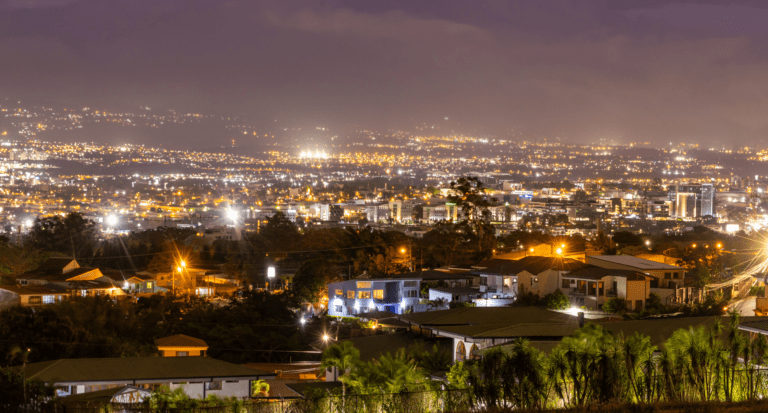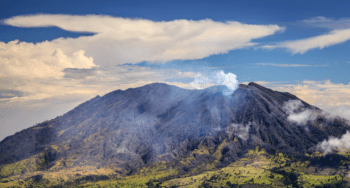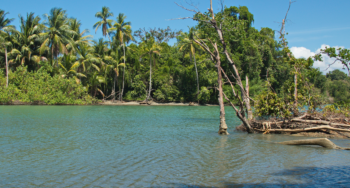SJO Airport Guide: What's Covered
Juan Santamaría Airport (SJO) sits in Alajuela—20km from San José, not downtown. This single-terminal airport handles immigration, baggage claim, and customs using a traffic light system. Arrive 3 hours early for international flights—airlines close check-in 60 minutes before departure. Rental car companies line the arrivals hall; vehicle pickup and insurance takes 45-60 minutes at off-site lots.
Quick Facts:
- Immigration takes 15-60 minutes, depending on arrival time—before 9 am and after 6 pm see shortest waits
- The domestic terminal is separate, 300m away, requiring 2-3 hours minimum for international-to-domestic connections
- Official orange taxis cost $25-30 to downtown; shared shuttles run $54-75 to destinations
- Free Wi-Fi limited to 30 minutes; paid options available for longer connections
- Green season (May-Nov) brings 10-15 minute immigration versus high season 30-60 minutes
Top 5 SJO Transportation Options:
- Rental Car – Most flexibility for exploring; allow 45-60 minutes for pickup process with mandatory insurance requirements
- Official Orange Taxis – Regulated meters, $25-30 to San José, immediate availability outside arrivals
- Shared Shuttles – Door-to-door service to Arenal ($60-70), Manuel Antonio ($65-75) on fixed schedules
- Public Buses – Extremely cheap ($1-1.50) but limited luggage space, run 5 am-10 pm to downtown
- Private Transfers – Complete flexibility, direct service, ideal for families or groups
If you need any help with a Costa Rica car rental, contact us now!
Your Costa Rica adventure starts the moment you land at Juan Santamaría International Airport (SJO), which handles over 5 million travelers yearly. Here’s the thing most people don’t realize: despite carrying San José’s name, the airport actually sits in Alajuela, about 20km northwest of the capital city.
Understanding how SJO works makes the difference between a chaotic arrival and a smooth start to your Costa Rican adventure. Named after Costa Rica’s national hero from the 1856 war against William Walker’s invaders, this airport has grown from modest beginnings into a modern facility serving over 30 international airlines.
Recent renovations have significantly improved the passenger experience. Yet SJO keeps enough local character to remind you that you’ve arrived somewhere special. Let me walk you through navigating SJO from arrival to departure, with insider tips that’ll help you breeze through like a local.
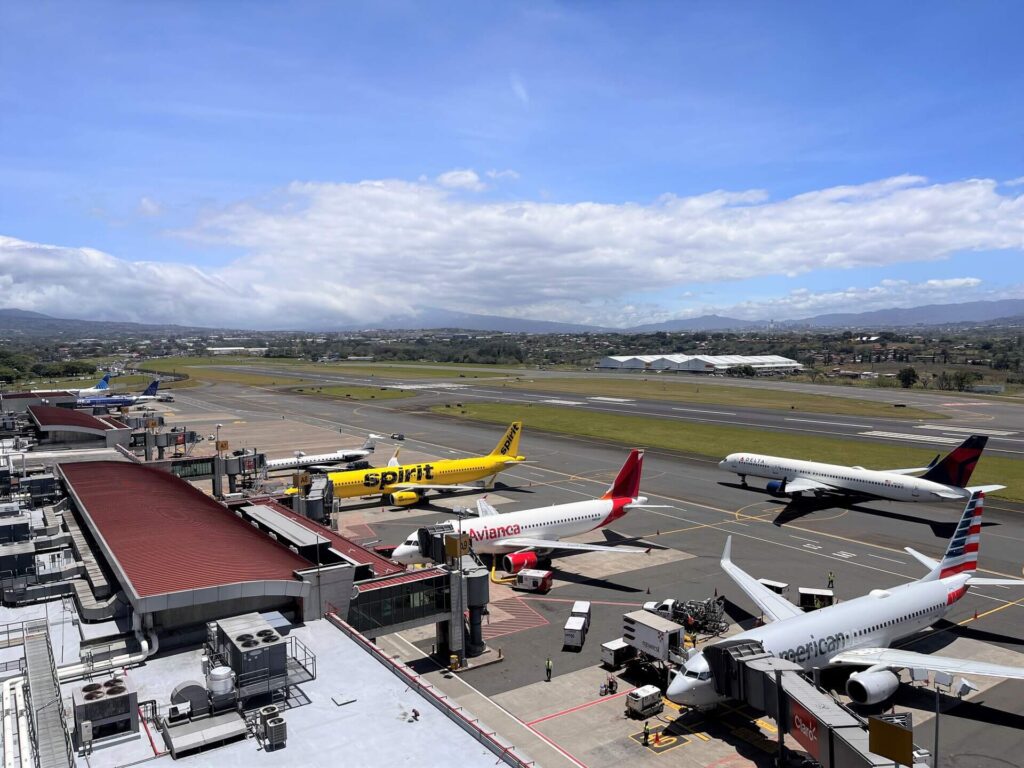
How Is SJO Airport Actually Laid Out?
Unlike sprawling international airports with multiple terminals and confusing connections, SJO features a single terminal building with clearly defined areas for arrivals and departures. This relatively compact design makes navigation straightforward once you understand the basic layout.
What’s on Each Level?
The terminal splits into two main levels, each serving distinct functions:
Level 1 (Ground Floor):
- International arrivals area where you’ll first enter after deplaning
- Immigration booths arranged in multiple lines
- Baggage claim with several carousels
- Customs processing using the traffic light system
- Transportation services and rental car counters along the exit wall
- Some food outlets and convenience stores for immediate needs
Level 2 (Upper Floor):
- Check-in counters organized alphabetically by airline
- Security screening checkpoints
- Departure gates divided into two concourses
- Duty-free shopping areas
- Most restaurants and retail options
- VIP lounges for eligible passengers
The airport operates with a logical flow that moves passengers from check-in through security to a central atrium area. From this central point, two main concourses extend in opposite directions.
Gates 1-12 serve primarily North American and European flights, making this concourse busier during morning departures. Gates 13-18 handle many Latin American and Caribbean destinations, with more activity in afternoon and evening hours.
Hidden gem: The renovated central atrium area between concourses features a small garden display showcasing Costa Rican plants. This provides a pleasant, quieter space to relax before flights, especially when gate areas get crowded.
Where’s the Domestic Terminal?
The domestic terminal operates as a separate, much smaller facility located about 300 meters from the main international building. If you’re connecting to destinations like Quepos, Drake Bay, or Tortuguero via local carriers like Sansa or Green Airways, you’ll need to exit the main terminal completely.
You can either walk (about 5-7 minutes along a partially covered pathway) or take a shuttle to this area. The domestic terminal is basic but functional, with limited seating and one small café.
Time buffer: Allow at least 2-3 hours between international arrival and domestic departures. You’ll need to complete immigration, collect luggage, clear customs, and transfer to the domestic terminal. During peak season, immigration alone can take an hour.
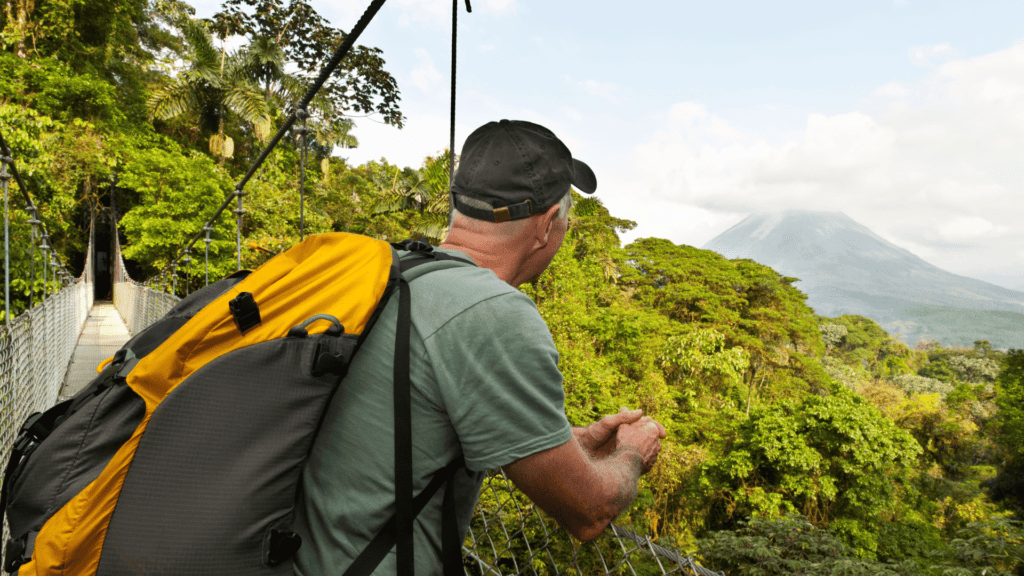
What Happens When You First Arrive at SJO?
Your Costa Rica experience kicks off the moment you deplane. Understanding the arrival process helps you move through efficiently.
How Long Does Immigration Take?
After disembarking, you’ll follow signs to immigration control. The walk from gates to immigration can take 5-10 minutes depending on your arrival gate. Costa Rica has modernized this process in recent years with digital forms and more booths, but queues still form during peak arrival times.
Peak arrival times typically run from mid-morning to early afternoon when multiple North American flights arrive simultaneously. Early morning arrivals (before 9 AM) and evening arrivals (after 6 PM) generally experience shorter waits.
Required documents:
- Valid passport (must be valid for the duration of your stay – even one day is sufficient)
- Completed digital immigration form (increasingly provided electronically before travel)
- Proof of onward travel within 90 days (return ticket or continuation to another country)
Immigration officers generally speak basic English, though greeting them with a simple “Hola” or “Buenos días” often sets a positive tone. They’ll stamp your passport with an entry permit valid for 90 days for most nationalities including US, Canadian, and EU citizens.
Speed trick: Have your immigration form completed and passport ready before reaching the booth. If traveling with family, stay together as one officer can process the entire group simultaneously, which is faster than splitting up.
Where Do You Get Your Bags?
The baggage claim area features several carousels clearly marked with corresponding flight information on overhead monitors. Free luggage carts are available throughout this area – grab one before heading to your carousel as they sometimes run out during busy periods.
Baggage typically starts appearing 15-20 minutes after you clear immigration. Priority baggage (business class and frequent flyer status) usually comes out first, followed by regular luggage.
Don’t forget: Before leaving the baggage claim area, check the oversized luggage section near the exit for items like surfboards, golf clubs, or car seats. These don’t appear on standard belts and are easy to miss.
What’s the Deal with Customs?
After collecting your bags, you’ll proceed to customs, where you’ll hand in your customs declaration form (typically distributed on your flight). Costa Rica uses a random selection traffic light system that determines whether your bags get inspected.
Press the button at the customs checkpoint:
- Green light: No inspection needed (randomly selected travelers) – about 70% get green
- Red light: Full inspection of luggage required – about 30% get selected
Most visitors are waved through without detailed inspection. However, agricultural products, large amounts of the same item (suggesting commercial import), and unusual equipment like drones or professional camera gear may trigger additional screening regardless of the light color.
What Services Are in the Arrival Hall?
Once through customs, you’ll enter the busy arrival hall. This can feel overwhelming after a long flight, but knowing what’s available helps.
Services immediately available include:
- Multiple ATMs from Banco Nacional and BAC (most reliable for international cards)
- Currency exchange booths (typically offering less favorable rates than ATMs)
- Information desk staffed 24/7 with English-speaking attendants
- Mobile phone SIM card vendors (Kolbi, Movistar, and Claro all have counters)
- Coffee shops and small convenience stores for immediate needs
- Tour operator desks for last-minute bookings
- Transportation service counters for shuttles and transfers
Money tip: For better exchange rates, withdraw colones directly from ATMs rather than exchanging currency at the airport booths. Currency exchange services typically charge 5-8% above the official exchange rate. ATMs dispense both colones and US dollars.
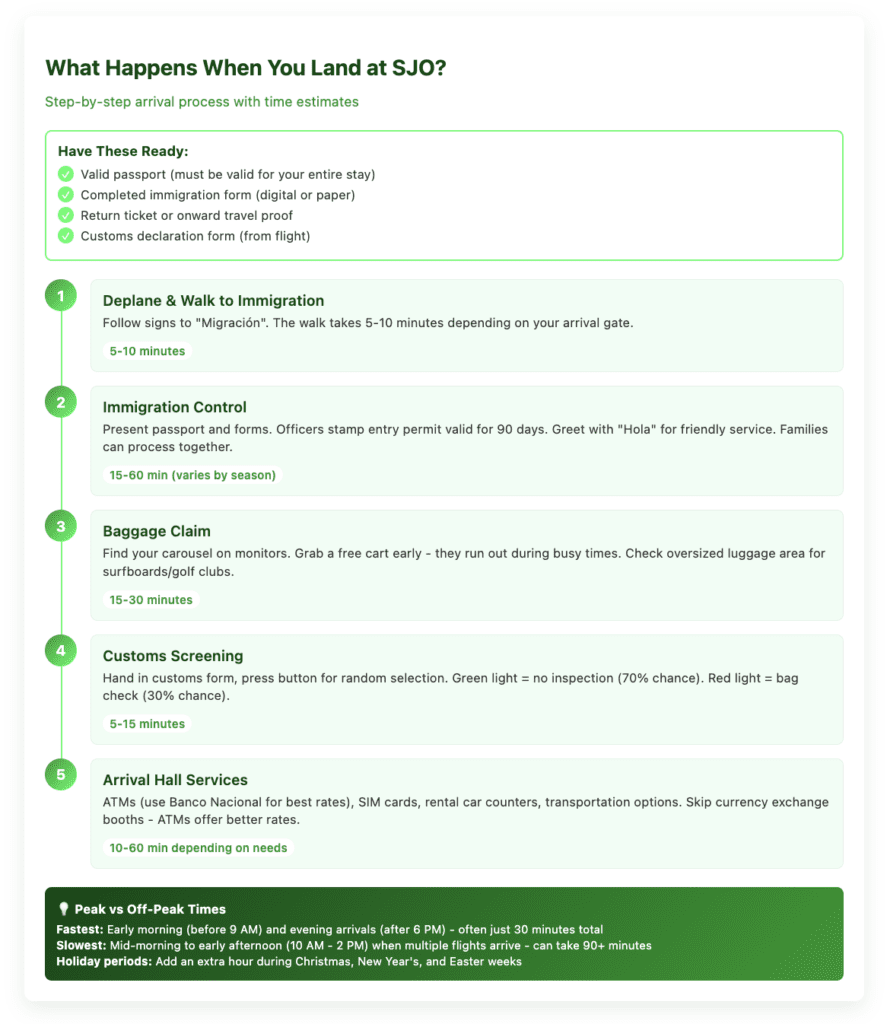
How Early Should You Arrive for Departure?
Departing through SJO requires some planning, particularly regarding airport arrival timing and check-in procedures. The airport has become stricter about timing in recent years.
What’s the Right Timing?
Costa Rica has implemented more rigorous security procedures in recent years, making earlier arrival times prudent:
- International flights: Arrive 3 hours before departure minimum
- Domestic flights: 1-1.5 hours before departure is usually sufficient
- Peak holiday periods (Christmas, Easter, July-August): Add an additional hour
Airlines typically close check-in 60 minutes before international departures and won’t make exceptions. Missing this cutoff means rebooking on a later flight.
Traffic reality: If coming from San José or the Central Valley, always add at least 30-45 minutes to your estimated driving time. Traffic becomes unpredictable during morning rush hour (6:30-8:30 AM) or afternoon congestion (4:00-6:30 PM). Friday afternoons are particularly bad.
How Does Check-In Work?
Check-in counters are arranged alphabetically by airline along the second floor of the terminal. Most international carriers open their counters 3 hours before departure and close them 60 minutes before.
Self-check-in kiosks are available for some major airlines, though not all offer bag drop capabilities. Even with online check-in, you’ll need to drop bags at the counter if checking luggage.
Airline-specific patterns:
- United, Delta, American, and Air Canada typically have the longest check-in lines, especially for morning departures
- European carriers often have more efficient check-in processes with better staffing ratios
- Southwest doesn’t offer advance seat assignment, so earlier check-in is advisable for better boarding position
- Copa and Avianca handle large volumes efficiently with Spanish-speaking staff
Smart move: If your airline offers online check-in 24 hours before departure, complete this process before arriving at the airport. Use the dedicated bag drop lines if traveling with checked luggage – these move much faster than regular check-in.
What About Security and Immigration?
After check-in, you’ll proceed to security screening, which follows standard international procedures. The security area can become a bottleneck during peak departure times (6-9 AM and 3-6 PM).
Security requirements match international standards:
- Liquids must be in containers of 100ml or less
- All liquids must fit in a single clear, resealable plastic bag
- Laptops and large electronics must be removed from bags
- Shoes typically don’t need to be removed unless they have metal
Following security, you’ll reach exit immigration, where officers check your passport and departure authorization. Although exit procedures are generally quick (5-10 minutes), this can become a bottleneck during peak periods when multiple flights depart simultaneously.
Departure tax note: There’s a departure tax of approximately $29 USD, which is typically now included in your ticket price. Verify this with your airline before departure, as some charter airlines and certain tickets still require separate payment at the airport.
Where Are the Gates?
After clearing security and immigration, you’ll find yourself in the main departures concourse with gates extending in both directions. The central area features shops and restaurants, while individual gates branch off from this main corridor.
Seating areas at individual gates can fill quickly during busy periods, especially for full flights to major US hubs. The central atrium offers additional seating and dining options if your gate area is crowded.
Stay alert: Gate changes are not uncommon at SJO and may not always be updated promptly on display boards. Listen carefully for announcements in both Spanish and English. Airport staff usually make rounds to notify passengers of changes.
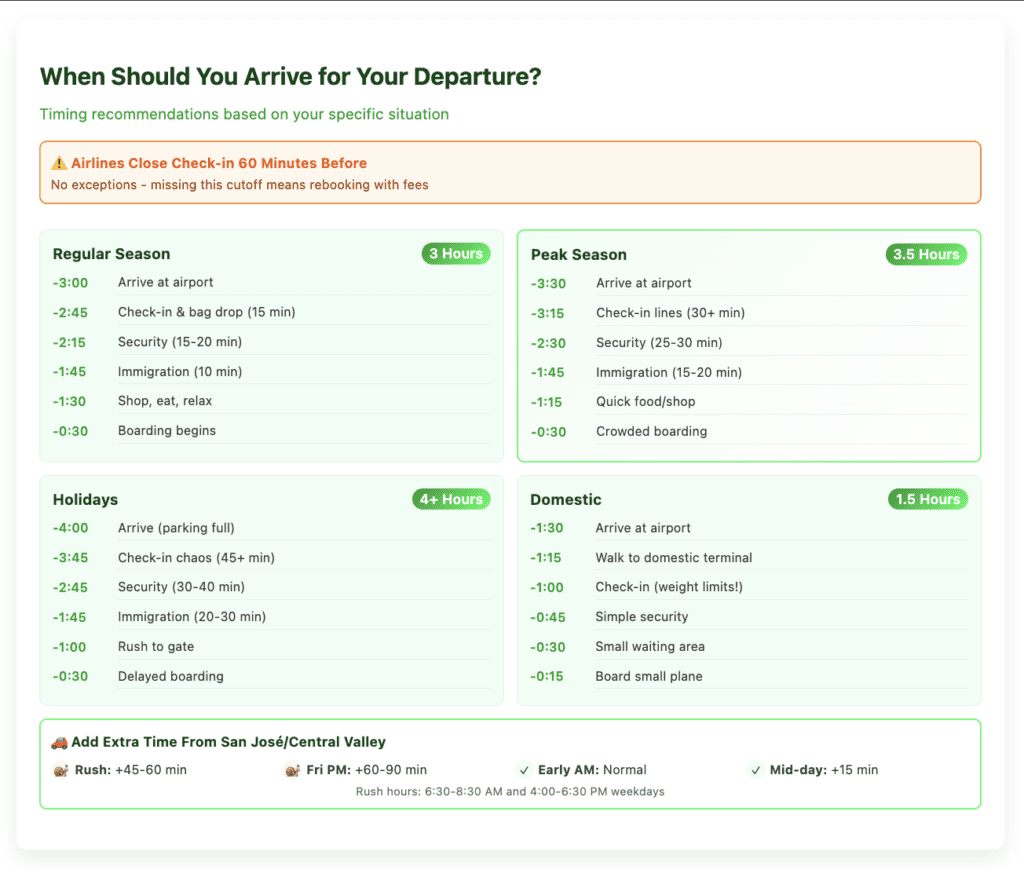
What Food and Shopping Options Exist?
SJO has significantly improved its amenities in recent years, though it still doesn’t offer the extensive services of major international hubs.
Where Can You Eat?
Food options have expanded dramatically with the recent renovations, offering everything from quick snacks to sit-down meals:
Pre-security (check-in area):
- Malinche Restaurant serves Costa Rican cuisine on the 2nd floor with table service
- Café Britt offers local coffee and quick bites including pastries and sandwiches
- Smashburger provides fast-casual burgers and fries
Post-security options are more extensive:
- Quiznos for submarine sandwiches and salads
- Restaurante Hacienda specializes in local dishes with full bar service
- Layover Bar offers drinks and pub food with TV screens for sports
- Starbucks Coffee for familiar favorites
- Various grab-and-go options throughout the concourses including packaged sandwiches and snacks
Authentic choice: For an authentic last taste of Costa Rica, Restaurante Hacienda in the main atrium offers traditional casados (typical Costa Rican meals with rice, beans, protein, and sides) at reasonable prices compared to other airport options. A full meal runs about $12-15.
What Can You Buy?
Retail options vary significantly between pre and post-security areas:
Pre-security shopping is limited to:
- Basic travel necessities like neck pillows and adapters
- Pharmacy items including over-the-counter medications
- Books and magazines in Spanish and English
- Small souvenir shops with basic items
Post-security shopping expands considerably:
- Duty-free shops selling liquor, tobacco, perfume, and electronics
- Café Britt store featuring coffee beans and Costa Rican souvenirs
- Artisan market with local crafts and handmade souvenirs
- Bookstore with extensive English and Spanish titles
- Fashion accessories and beachwear
- Costa Rican snacks and packaged foods
Coffee tip: Café Britt offers vacuum-sealed coffee packages ideal for bringing home Costa Rica’s famous beans. Their airport prices are comparable to city stores, making last-minute coffee purchases convenient and economical. A pound of premium coffee runs $12-18.
What Other Services Are Available?
SJO offers standard airport services with some local variations:
Basic services throughout the terminal:
- Wi-Fi: Free for 30 minutes, with paid options for longer connections ($5 for 2 hours, $10 for 24 hours)
- ATMs: Located in both arrival and departure areas, dispensing colones and dollars
- Currency exchange: Multiple booths throughout the terminal with extended hours
- Charging stations: Available but limited; bring a portable battery if possible
- Prayer room: Located near Gate 5 for all faiths
- Family restrooms: Available in both concourses with changing tables
- Medical services: Basic first aid station on the main floor staffed during operating hours
VIP Lounges offer refuge from crowded gates:
- VIP Santamaría Lounge: Access through Priority Pass, certain credit cards, or paid entry ($30-35)
- United Club: For Star Alliance Gold members and business class passengers
- Avianca Sala VIP: For Star Alliance passengers and paid entry ($40)
Each lounge offers complimentary snacks, drinks (including alcohol), Wi-Fi, comfortable seating, and quieter atmosphere. Some offer shower facilities for long layovers.
Coffee secret: For the best coffee in the airport, skip the international chains and head to Café Britt. Their trained baristas can explain the characteristics of different Costa Rican growing regions while preparing your drink with local beans.

How Do You Get To and From SJO?
SJO’s location in Alajuela (not San José proper) influences your transportation options and timing considerations. The 20km distance to downtown San José can take anywhere from 30 minutes to over an hour depending on traffic.
Should You Rent a Car?
All major rental companies maintain counters in the arrivals area, lined up along the wall after you exit customs. After completing paperwork at the counter, most companies shuttle you to off-site locations to collect vehicles – usually a 5-10 minute ride.
Important considerations for car rentals:
- Costa Rica requires mandatory basic insurance regardless of your credit card or personal coverage
- A valid driver’s license from your home country is sufficient (an international permit is not required for stays under 90 days)
- Budget for a security deposit hold of $750-1500 on your credit card, depending on vehicle type
- Most agencies require drivers to be at least 21 years old (some charge extra fees for drivers under 25)
Time management tip: Allow at least 45-60 minutes for the rental car pickup process, even with reservations. This includes paperwork, shuttle time, and vehicle inspection. With Vamos Rent-A-Car, we streamline this process but still recommend this buffer for planning purposes.
What About Official Taxis?
Orange “Taxis Unidos” are the only official airport taxis, operating from a designated stand outside arrivals. They operate with regulated meters (called “marias”) and are generally reliable, though drivers’ English varies.
Approximate fares to common destinations:
- Airport to downtown San José: $25-30
- Airport to Alajuela center: $10-15
- Airport to Heredia: $25-30
- Airport to Escazú and western suburbs: $30-35
- Airport to Santa Ana: $35-40
Fares increase 20% after 10 PM. All official taxis should use meters – if a driver claims it’s broken or offers a flat rate, find another taxi.
Safety tip: Use only the official orange airport taxis from the designated stand outside arrivals. Decline offers from unregistered drivers approaching you inside the terminal, no matter how good their price seems.
How Do Shuttles Work?
Pre-booked shuttle services offer convenient door-to-door transportation to major tourist destinations throughout Costa Rica.
Shared shuttles provide economical options:
- Cost-effective for solo travelers or couples
- Fixed departure schedules (typically 8:00 AM, 11:00 AM, 2:00 PM)
- Major routes: SJO to Arenal ($60-70), SJO to Manuel Antonio ($65-75), SJO to Monteverde ($60-70)
- Journey times range from 2.5 to 4 hours depending on destination
- Include stops at other hotels for passenger pickup/dropoff
Private transfers offer more flexibility:
- More expensive but offers complete schedule flexibility
- Direct service with no additional stops
- Comfortable vehicles with professional drivers
- Can accommodate families or groups more economically than multiple shuttle seats
- Available 24/7 including late-night arrivals
Booking advice: Reserve shuttle services at least 3-5 days in advance during high season, especially for popular routes to Arenal or Manuel Antonio. Private transfers can often be arranged with 24-hour notice.
Can You Take Public Buses?
The most economical option for budget travelers, though requiring more navigation:
Airport to San José downtown:
- Tuasa buses depart from just outside the airport to downtown San José
- Approximate fare: 550-650 colones ($1-1.50)
- Journey time: 35-45 minutes plus walking time
- Frequency: Every 10-15 minutes during daytime hours (5 AM to 10 PM)
- Buses stop running after 10 PM
Airport to Alajuela city center:
- The bus stop is a 10-minute walk from the terminal
- Fare: 550 colones (approximately $1)
- Journey time: 15-20 minutes
- More frequent service than San José route
Bus travel reality: These services are best for independent travelers with minimal luggage, as space is limited and buses can become crowded during peak hours. No luggage compartments exist – you’ll need to hold bags on your lap.
What About Uber and DiDi?
Ride-sharing services operate in Costa Rica, though their airport pickup situation exists in a legal gray area:
- Drivers cannot pick up at the immediate terminal curb due to agreements with official taxis
- You’ll typically need to walk to the parking structure or nearby public areas
- Services are generally reliable once the connection is established
- Often more economical than airport taxis for longer journeys
- Both apps work with US phone numbers and credit cards
Pickup strategy: For Uber/DiDi pickups, walk to the pedestrian bridge connecting to the parking structure and request your ride from there to avoid potential conflicts with official taxi drivers. Some drivers may ask you to sit in the front seat to appear less commercial.
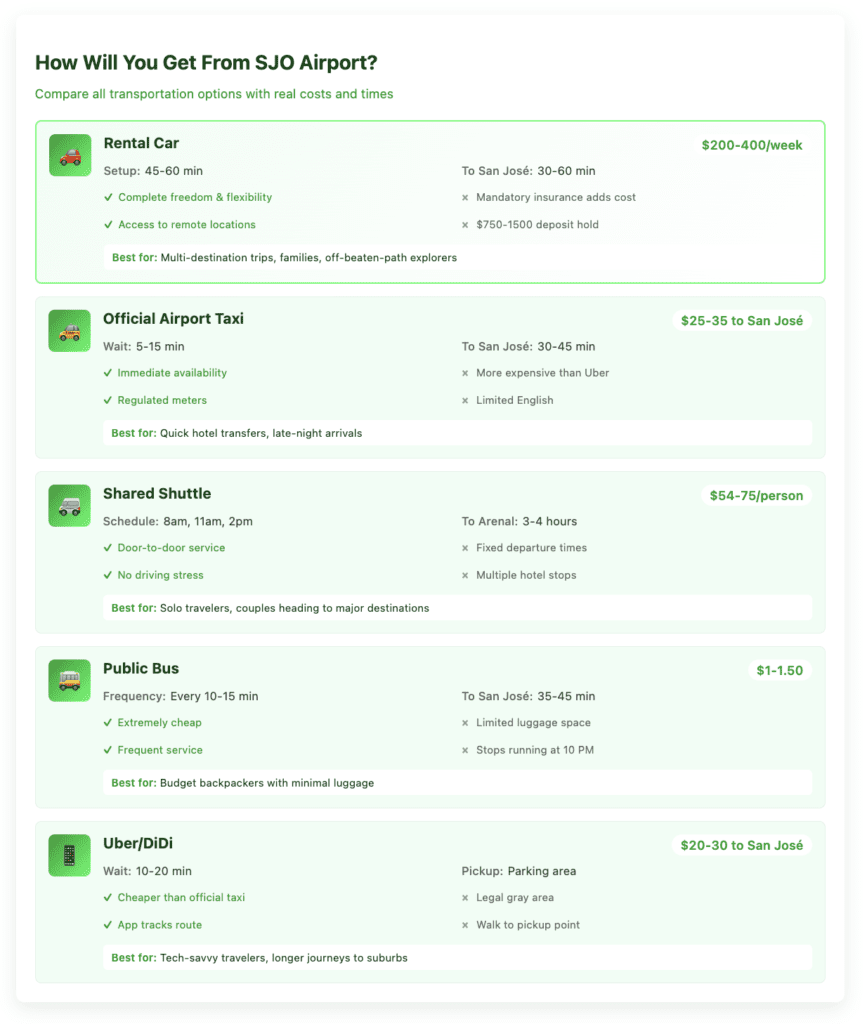
Where Should You Stay Near SJO?
Staying near the airport is practical for late arrivals or early departures, with options ranging from basic transit hotels to comfortable properties with additional amenities.
Which Hotels Are Walking Distance?
Several properties are close enough to reach on foot, though sidewalks are limited in some areas:
- Holiday Inn Express San José Airport – Modern rooms with included breakfast and airport shuttle every 30 minutes
- Hampton Inn & Suites San José Airport – Reliable chain property with pool and restaurant, free 24-hour shuttle
- City Express San José Aeropuerto – Budget-friendly option with basic amenities and hourly shuttle service
These properties are 5-10 minutes from the terminal but the walk isn’t pleasant at night or with heavy luggage. Most offer free shuttle service.
What’s Available Within 10-15 Minutes?
Expanding your radius slightly offers more options and often better value:
- Hotel Buena Vista – Hillside location with volcano views and colonial charm, popular restaurant
- Hotel La Rosa de América – Garden setting with tropical atmosphere and pool, quiet location
- Courtyard by Marriott San José Airport Alajuela – Business-friendly with good restaurants and modern amenities
These properties require transportation but offer better amenities and often lower rates than immediate airport hotels.
Booking strategy: Airport hotels fill quickly during high season, particularly for dates immediately after major international flight arrivals. Book at least a month ahead for December-April stays. Many offer park-and-fly packages for Costa Rican residents.
What Practical Tips Should You Know?
How Should You Handle Money?
Understanding Costa Rica’s dual-currency system helps avoid confusion:
- Local currency: The Costa Rican colón (₡) is the official currency, though US dollars are widely accepted
- Exchange rates: As of March 2025, approximately ₡530-550 to $1 USD
- ATM recommendations: Banco Nacional ATMs typically charge the lowest fees for foreign cards
- Currency needs: Withdraw enough colones for immediate transportation and small purchases
Most services at the airport accept credit cards, but having about $50 worth of colones for initial expenses is recommended, particularly if you’re arriving late when some services close.
Money tip: Avoid exchanging money at hotel desks which often offer the worst rates. Banks in town offer better rates than the airport, but ATMs are usually your best option.
What About Security?
Standard travel precautions apply at SJO:
- Keep valuables secure and not visible
- Use official transportation options only
- Be alert in crowded areas, particularly baggage claim
- Avoid displaying expensive electronics or jewelry
- Keep copies of important documents separate from originals
Safety insight: SJO has significantly improved security in recent years, with cameras throughout and visible police presence. The airport itself is generally safe, but standard travel precautions remain advisable. Petty theft occasionally occurs in parking areas.
What Mistakes Should You Avoid?
Common errors that complicate travel:
- Confusion about location: Remember SJO is in Alajuela, not San José (20km from downtown)
- Underestimating traffic: Always add buffer time for the journey to the airport
- Currency confusion: Verify whether prices are quoted in dollars or colones (prices with commas are typically in colones)
- Departure tax oversight: Though usually included in tickets now, verify this before arrival
- Airport name confusion: Don’t confuse Juan Santamaría (SJO) with Tobías Bolaños (SYQ), San José’s much smaller domestic airport
Planning tip: If you’re departing Costa Rica during the last days of a major holiday period (particularly after New Year’s or Easter Week), add an extra hour to your recommended arrival time as these are exceptionally busy periods.
What If You're Traveling with Special Needs?
Families with Children?
SJO accommodates families reasonably well:
- A small play area is located near Gate 5 (post-security)
- Family restrooms are available in both concourses
- Most restaurants offer children’s menu options
- Baby changing facilities are available in most restrooms
- Stroller-friendly ramps throughout the terminal
Family tip: Request seating near the front of the immigration area if traveling with young children. Officers will occasionally expedite processing for families with infants or toddlers. Some airlines offer family pre-boarding.
Travelers with Disabilities?
Accessibility has improved significantly:
- Wheelchair assistance is available (request through your airline in advance)
- Accessible restrooms in all areas meet international standards
- Priority lines at security and immigration for those who need them
- Elevator access between levels
- Designated parking spaces close to terminal entrance
Accessibility note: While SJO has improved accessibility significantly, advanced requests for assistance are strongly recommended to ensure services are readily available upon arrival. Airport wheelchairs are limited.
Solo Travelers?
Solo travel through SJO is generally safe with basic precautions:
- Keep belongings in sight, particularly in crowded areas
- Consider pre-arranged transportation for late-night arrivals
- Share taxi rides with other travelers heading to similar destinations to reduce costs
- Public buses are safe, but require more navigation experience
Many solo travelers connect at the airport information desk to share transportation costs.

How Does Season Affect Your SJO Experience?
The airport experience varies significantly with Costa Rica’s tourist seasons, affecting everything from immigration wait times to transportation availability.
High Season (December-April)?
Peak tourist season brings challenges:
- Longer wait times at immigration (30-60 minutes are not uncommon)
- More expensive transportation options with less availability
- Need for advance booking of shuttle services
- Higher occupancy at airport hotels
- Earlier recommended arrival times for departures
Peak period alert: The weeks around Christmas/New Year and Easter (Semana Santa) see the heaviest passenger volumes, with immigration lines potentially exceeding an hour during peak arrival times (10 AM-2 PM). These periods also see more flight delays and cancellations.
Green Season (May-November)?
Off-peak travel has significant advantages:
- Significantly shorter immigration and security lines
- More negotiable transportation rates
- Greater availability of shuttle services without advance booking
- Airport hotels often offer promotional rates (30-40% discounts common)
- More relaxed overall atmosphere
Green season advantage: Arrivals between September-November often experience minimal waiting, with immigration processing sometimes taking as little as 10-15 minutes. This is ideal for travelers who value efficiency over weather.
Where Can You Fly From SJO?
Which Domestic Destinations?
The domestic terminal serves several local destinations, primarily through these carriers:
Sansa Airlines operates scheduled service to:
- Manuel Antonio/ Quepos (25 minutes flight time)
- Drake Bay (45 minutes)
- Puerto Jiménez (50 minutes)
- Tamarindo (45 minutes)
- Liberia (30 minutes)
- Tambor (35 minutes)
Green Airways specializes in:
- Tortuguero (30 minutes)
- Nosara (45 minutes)
- La Fortuna/ Arenal (30 minutes)
Domestic flight tip: These small aircraft (typically 12-19 seats) have strict luggage restrictions of 30 pounds (14kg) per person, including carry-ons. Excess baggage fees are high ($1-2 per pound), so pack accordingly or arrange luggage storage at SJO.
Which International Connections?
SJO offers direct connections to major destinations across the Americas and Europe:
North America routes include:
- Multiple daily flights to US hubs (Miami, Houston, Atlanta, Los Angeles)
- Direct service to over 15 US cities
- Toronto and Montreal, Canada with seasonal increases
- Mexico City with connections throughout Mexico
Central/South America connections:
- Panama City serves as major connection hub via Copa
- Bogotá, Colombia via Avianca
- Lima, Peru direct and via connections
- All Central American capitals with regional carriers
European service (varies by season):
- Madrid, Spain year-round via Iberia
- Frankfurt, Germany via Lufthansa
- London, UK (seasonal via British Airways)
- Paris, France (seasonal via Air France)
- Amsterdam, Netherlands (seasonal via KLM)
Airline hub note: Copa Airlines (via Panama City) and Avianca (via El Salvador) offer the most extensive connection options to South American destinations if direct flights aren’t available.
Your Most Common SJO Questions Answered
Q: How early should I arrive at SJO for my departure?
A: For international flights, arrive 3 hours before departure; for domestic flights, 1.5 hours is usually sufficient. Add more time during high season or holiday periods. Airlines close check-in 60 minutes before international departures.
Q: Is there anywhere to sleep in the airport for overnight layovers?
A: SJO doesn’t have dedicated sleeping areas or pods. The airport technically closes overnight (approximately 12 AM to 4 AM), and passengers aren’t permitted to remain inside during these hours except in special circumstances. Consider booking an airport hotel for overnight connections.
Q: Can I store luggage at the airport?
A: Yes, luggage storage is available near the domestic terminal and rental car desks on Level 1. The service costs approximately $5-8 per bag for 24 hours. Valid ID is required. They accept cash only.
Q: Is the water safe to drink at SJO?
A: Yes, tap water throughout the airport is potable, as it is throughout most of Costa Rica. Water fountains are available past security for refilling bottles. This saves money on bottled water purchases.
Q: What happens if I miss my flight from SJO?
A: Contact your airline representative immediately at their check-in counter. Most airlines have multiple daily flights to major hubs and can rebook you, though fees may apply depending on your ticket type and the reason for missing your flight.
Q: Can I bring food through security at SJO?
A: Solid foods are generally permitted through security, though liquids over 100ml are prohibited. Food purchased after security can be taken onto flights. This is useful for long flights or if you have dietary restrictions.
Ready to Navigate SJO Like a Pro?
Juan Santamaría International Airport serves as both your introduction to Costa Rica and your final farewell. While not the most glamorous or expansive international airport, recent improvements have made it a functional and increasingly pleasant gateway.
Remember that Costa Rican culture embraces “pura vida” (pure life) – a relaxed, positive approach to life that sometimes means processes move more slowly than you might expect in major international hubs. Bringing patience and a positive attitude navigates not just the airport but sets the tone for your entire Costa Rican experience.
For most visitors, SJO represents just the beginning of an unforgettable adventure in one of the world’s most biodiverse countries. The mountains visible from the terminal windows hint at the natural wonders awaiting beyond, while the friendly immigration welcome reflects the warmth you’ll encounter throughout your stay.
Whether you’re preparing for your first visit or returning to this remarkable country, understanding SJO’s systems helps transform what could be a stressful transit point into the smooth beginning and end of your Costa Rican journey. With these insights, you’re ready to navigate SJO with confidence.
¡Buen viaje y pura vida!
